
Yale University is a private Ivy League research university in New Haven, Connecticut. Founded in 1701, Yale is the third-oldest institution of higher education in the United States and one of the nine colonial colleges chartered before the American Revolution.

The Metropolitan Transportation Authority (MTA) is a public benefit corporation responsible for public transportation in the New York City metropolitan area of the U.S. state of New York. The MTA is the largest public transit authority in North America, serving 12 counties in Downstate New York, along with two counties in southwestern Connecticut under contract to the Connecticut Department of Transportation, carrying over 11 million passengers on an average weekday systemwide, and over 850,000 vehicles on its seven toll bridges and two tunnels per weekday.

Briarwood is a middle-class neighborhood in the New York City borough of Queens. The neighborhood is roughly bounded by the Van Wyck Expressway to the west, Parsons Boulevard to the east, Union Turnpike to the north, and Hillside Avenue to the south.

The Port Authority Bus Terminal is a bus terminal located in Manhattan in New York City. It is the busiest bus terminal in the world by volume of traffic, serving about 8,000 buses and 225,000 people on an average weekday and more than 65 million people a year.

The Prospect Park Zoo is a 12-acre (4.9 ha) zoo located off Flatbush Avenue on the eastern side of Prospect Park, Brooklyn, New York City. As of 2016, the zoo houses 864 animals representing about 176 species, and as of 2007, it averages 300,000 visitors annually. The Prospect Park Zoo is operated by the Wildlife Conservation Society (WCS). In conjunction with the Prospect Park Zoo's operations, the WCS offers children's educational programs, is engaged in restoration of endangered species populations, runs a wildlife theater, and reaches out to the local community through volunteer programs.
Immediately after World War II, New York City became known as one of the world's greatest cities. However, after peaking in population in 1950, the city began to feel the effects of suburbanization brought about by new housing communities such as Levittown, a downturn in industry and commerce as businesses left for places where it was cheaper and easier to operate, an increase in crime, and an upturn in its welfare burden, all of which reached a nadir in the city's fiscal crisis of the 1970s, when it barely avoided defaulting on its obligations and declaring bankruptcy.
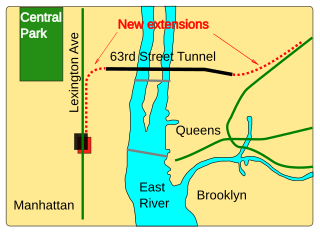
The 63rd Street Tunnel is a double-deck subway and railroad tunnel under the East River between the boroughs of Manhattan and Queens in New York City. Opened in 1989, it is the newest of the East River tunnels, as well as the newest rail river crossing in the New York metropolitan area. The upper level of the 63rd Street Tunnel carries the IND 63rd Street Line of the New York City Subway. The lower level carries Long Island Rail Road (LIRR) trains to Grand Central as part of the East Side Access project.
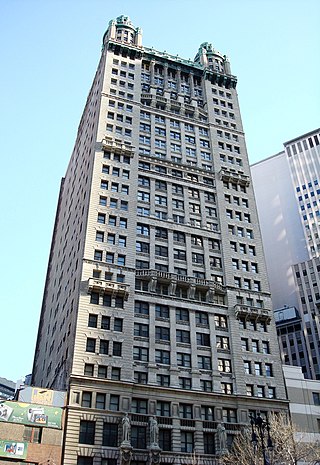
Park Row is a street located in the Financial District, Civic Center, and Chinatown neighborhoods of the New York City borough of Manhattan. The street runs east-west, sometimes called north-south because the western end is nearer to the Financial District. At the north end of Park Row is the confluence of Bowery, East Broadway, St. James Place, Oliver Street, Mott Street, and Worth Street at Chatham Square. At the street's south end, Broadway, Vesey Street, Barclay Street, and Ann Street intersect. The intersection includes a bus turnaround loop designated as Millennium Park.

The 49th Street station is a local station on the BMT Broadway Line of the New York City Subway. Located at West 49th Street and Seventh Avenue in Midtown Manhattan, it is served by the N train at all times, the R train at all times except late nights, the W train on weekdays, and the Q train during late nights.

The Lexington Avenue/59th Street station is a New York City Subway station complex shared by the IRT Lexington Avenue Line and the BMT Broadway Line. It is located at Lexington Avenue between 59th and 60th Streets, on the border of Midtown and the Upper East Side of Manhattan. The station complex is the fourteenth-busiest in the system, with over 21 million passengers in 2016.

The Tweed Courthouse is a historic courthouse building at 52 Chambers Street in the Civic Center of Manhattan in New York City. It was built in the Italianate style with Romanesque Revival interiors. William M. "Boss" Tweed – the corrupt leader of Tammany Hall, a political machine that controlled the New York state and city governments when the courthouse was built – oversaw the building's erection. The Tweed Courthouse served as a judicial building for New York County, a county of New York state coextensive with the New York City borough of Manhattan. It is the second-oldest city government building in the borough, after City Hall.
Artspace was a contemporary art gallery and non-profit organization located in downtown New Haven, Connecticut. Artspace closed its physical location in June 2023 and announced plans to operate remotely.
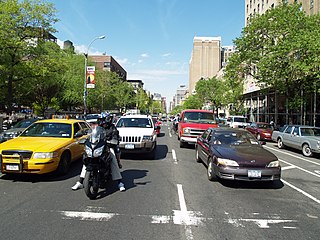
In New York City, a planned congestion pricing scheme will charge vehicles traveling into or within the central business district of Manhattan. First proposed in 2007, this disincentivizing fee to cut down on traffic congestion was approved and included in the 2019 New York State budget.

Michael Aloysius Tabor was an American political activist and member of the Black Panther Party who was charged and tried as part of an alleged conspiracy to bomb public buildings in New York City and kill members of the New York Police Department.
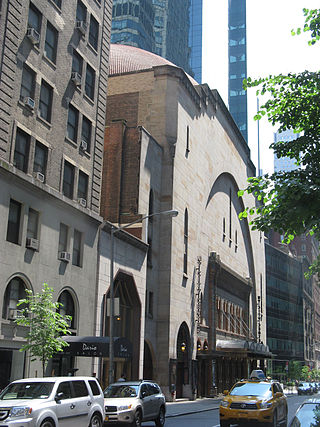
New York City Center is a performing arts center at 131 West 55th Street between Sixth and Seventh Avenues in the Midtown Manhattan neighborhood of New York City. Developed by the Shriners between 1922 and 1924 as a Masonic house of worship, it has operated as a performing arts complex owned by the government of New York City. City Center is a performing home for several major dance companies as well as the Manhattan Theatre Club (MTC), and it hosts the Encores! musical theater series and the Fall for Dance Festival annually.

The New York Police Department's Strategic Response Group (SRG) is a unit of the New York City Police Department (NYPD) formed in 2015 for counter-terrorism and the policing of political protests. They maintain a bike squadron and are outfitted with anti-riot gear, rifles, and body armor. The unit has been criticized for its use of excessive force and mass arrests against political demonstrators protected under the First Amendment, disproportionately high numbers of complaints to the Civilian Complaint Review Board, and the killing of unarmed men, among other things. Activists, the New York City Council, the New York City Department of Investigation, and organizations such as Human Rights Watch and the New York Civil Liberties Union, among others, have called for its regulation or disbandment.
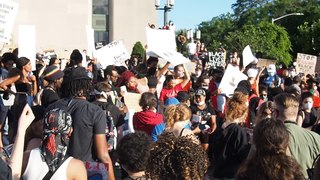
George Floyd protests in New York City took place at several sites in each of the five New York City boroughs, starting on May 28, 2020, in reaction to the murder of George Floyd. Most of the protests were peaceful, while some sites experienced protester and/or police violence, including several high-profile incidents of excessive force. Looting became a parallel issue, especially in Manhattan. As a result, and amid the COVID-19 pandemic, the city was placed under curfew from June 1–7, the first curfew in the city since 1943. The protests catalyzed efforts at police reform, leading to the criminalization of chokeholds during arrests, the repeal of 50-a, and other legislation. Several murals and memorials have been created around the city in George Floyd's honor, and demonstrations against racial violence and police brutality continued as part of the larger Black Lives Matter movement in New York City.
The Iranian Students Association in the United States(ISAUS) was an American national student group for the Iranian diaspora, active from 1952 until the early 1980s. By the early 1960s, the group transformed into a significant portion of the membership of the Confederation of Iranian Students National Union (CISNU). The ISAUS was still active during the Iranian Revolution between 1977 and 1978, holding national protests and publishing information against Shah Mohammad Reza Pahlavi.
George Sumner Bradford Dana Gould was an American financier and banker. Gould was a member of the board of Municipal Assistance Corporation that was constituted during the 1975 New York City fiscal crisis and briefly served as its chairman in 1979. He was the Undersecretary of the Treasury in the late 1980s during the Reagan administration. During this period he oversaw the savings and loan crisis, the aftermath of the 1987 Black Monday stock market crash, and the raising of the country's debt ceiling.

Edward Arnold Hanna was an American businessman and politician. He was mayor of Utica, New York, from 1974 to 1978 and from 1996 to 2000, running as an independent. Often described as a populist, Hanna was widely regarded as eccentric and abrasive and constantly clashed with the Utica business and political establishment, the rest of city government, and other local groups. A "non-stop talker" who The New York Times called "flamboyant, combative, and controversial", he once described Utica as "a stinking, rotten town" and "a lousy place to live" and told Uticans to move away for better opportunities. He built and renovated a number of parks and public artworks during his terms. However, Hanna failed to stem Utica's long-term economic and population decline.
















